The Lost Art of Entryway Mosaic
How many times have you walked over something on your daily routine, and not noticed or appreciated it until sometime much later? The feeling was one I recently had on two occasions: the first involving cobblestone paths, and the other dirt paths. One is a deliberate creation, the other out of convenience.
On the third installment of this walking-related series, we’re going to explore the artwork underneath us as we walk in to early 20th century commercial buildings downtown.
When I think of the era in which these mosaics were commonplace across the country, I think of a few adjectives to describe building styles: ornate, solid, and permanent. Businesses frequently advertised in the form of painted murals on the side of the building, and signs were conspicuous and loud, often with neon lighting.
Mecca is the only business still in operation that has its name on the entryway (that I could find).
It seems that back then, a business operated over a longer lifespan, or at least planned to. One of the ways in which these businesses declared their presence was in the form of tile mosaic entryways.
Some were added after the building was erected, such as with the Heilig-Levine building above. Observe the tiling says Heilig & Meyers.
The entrance to Twine Interactive on Fayetteville Street, minus a business name or address.
The largest collection of these by far is on Hargett Street, in the cluster of buildings owned by Empire Properties. On the stretch between Fayetteville Street and Wilmington Street lies five contiguous and nearly pristine examples.
In the example above, the store name was ‘Pizer Bros. Co’, currently the entry to the Morning Times. According to Will, who works there, the location was home to a zoot suit maker in the 30s.
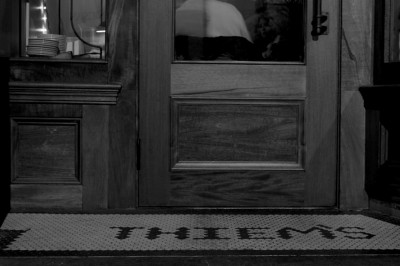
Until getting the photo above, I had never noticed the alternate spelling of  ‘Times’
EDIT: As was pointed out, Thiem’s was a family name of a business that operated here.Â
Adjacent to the Thiem’s mosaic is the one for the Raleigh Times.
It’s interesting to think of why these decorative mosaics fell out of fashion. According to the description in a related flickr group, it lasted until about the mid part of the last century. At that time the modernist movement was disconnecting from the past, so it likely influenced the gradual shift to the shiny terrazo flooring that eventually replaced it.
One of the complaints of many new types of building, whether it be commercial or residential, is that it isn’t built to last. Materials are lightweight and cheap, and it lacks soul. The once prevalent style of mosaic entryways should make a comeback in modern buildings. My suggestion: be it address or business name, create something interesting (yet simple) to look at when entering a building. You know the phrase, relating to first impressions and all.
So what entryways have I missed? Better yet, do you have photos of this style? Send them to us and we’ll add to this post.

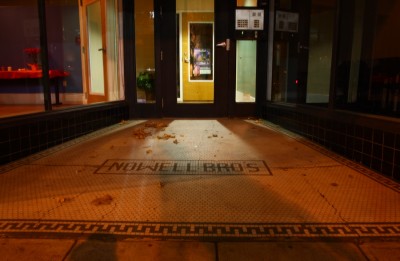
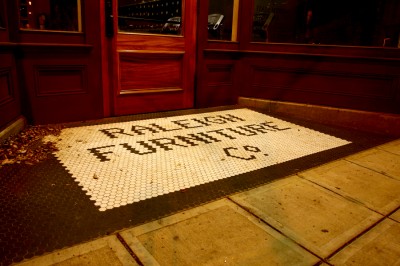
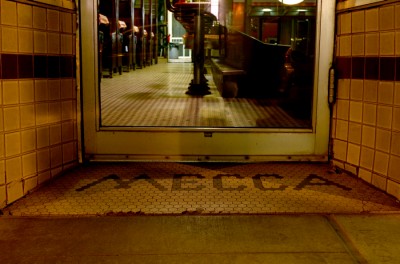
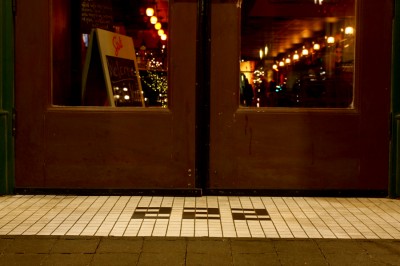
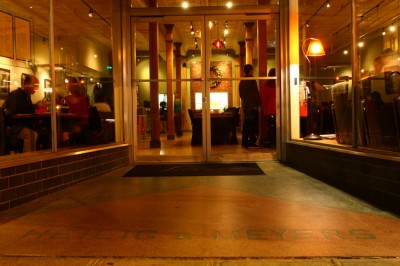
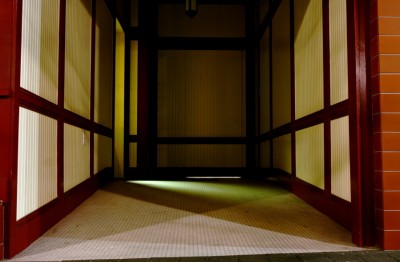
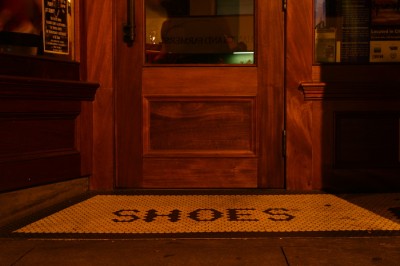
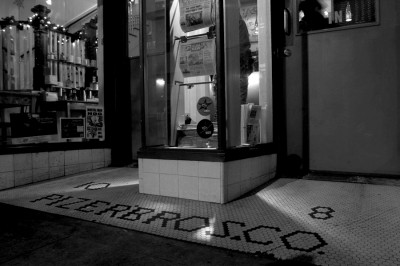
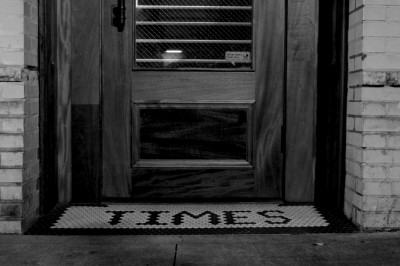

 Sign up for the Newsletter
Sign up for the Newsletter
12/17/2009
John, very cool, arcane even– and you’re right– everybody sees those mosaics, but nobody notices. One thing though, ‘Thiems’ is not a misspelling of ‘Times.’ It is ‘Thiem,’ a family name, and the shop is a former office supply store.
12/17/2009
Miniature robots from outerspace recently rebuilt the vestibule mosaic in my building.
12/17/2009
Thanks so much for this article. Mosaic entryways and signage are truly a lost art. (I’m also thinking of the beautiful, though now grimy, mosaics at subway stops in NYC.) The permanence and optimism they implied is fascinating.
12/17/2009
Very cool! One of the Thiems (James)also had a record shop. The N&O once called it the “outpost of hipness.”
12/17/2009
ohmygosh that ‘theims’ thing has bugged me for YEARS! :) thanks for creating a forum to clear it up!
12/17/2009
I live in the Prairie Building and I notice and enjoy it’s entryway mosaic every time I walk across it. Thanks for the article.
12/17/2009
Jimmy Thiem owned the record shop and it was a sad, sad day when it closed in the early 70s. I bought my much older brother a pile of R&B 78’s at Thiem’s going-out-of-business sale. Twas the only place in mid-60s Raleigh where you could buy UK imports. Not at Stephenson’s which was the other well-stocked shop (sold music instruments). Thiem’s listening booths in back might be packed after school or Saturday afternoon with budding Mods sampling the latest Yardbirds, Creation or Small Faces.
If I remember correctly, Tom Jones clothier was just a few doors down. Not that any of us (well, a few) could afford to buy anything there except for a shirt or some hip trinket.
12/22/2009
LOL @ Kevin– i forgot, what was the name of that movie?
12/22/2009
@RaleighBob “Batteries not Included”
12/23/2009
I have always loved the mosaic at Mecca but you’re right, I don’t think I stop to actually appreciate it – thanks for making a list of all the others as well.
12/27/2009
OMG….Thiem’s! As someone has pointed out already, Thiem is a family name, not an alternate spelling of “Times”. Mr.& Mrs. James Thiem Sr. were the uncle/aunt of my grandmother; James Thiem Jr./”Jimmy” was her (much younger) cousin. His son, James III is my contemporary and now lives in the N. Blount Street area.
07/03/2012
In a thrift shop in Jacksonville FL today I found a Parker Brothers game called Contack. Hexagonal box, 3-3/4 inches in diameter, with instructions enclosed, complete with wooden triangle pieces. On the front is shield-shaped sticker that says Thiem’s–Raleigh–N.C. On the back of the box is an inked stamp that says James E. Thiem–Gifts–Favors–Raleigh, N.C. The instructions are dated 1939, so around that time Thiem’s was selling a game called Contack, and one came into the possession of Philip Leonis Dughi, as he printed his name on the back of the box. Very cool little history and I’m glad I found this site and the Thiem’s mosaic.
06/07/2016
I used to buy records at Thiem’s Record Shop on Hargett St, had a card, buy so many, get one free, around 1959.
07/21/2018
I came across this tribute to the Raleigh I knew in high school when I Googled “Thiem’s Record Store 1960 Raleigh, NC.” (I’ve lived in Boston since I graduated from Duke in 1966.) I knew a niece of Jimmy Thiem’s (I think she was his niece): Katherine Ruffner. But I knew Jimmy Thiem much better. I spent hours in that shop (it was up on the second floor and accessible, as I vaguely recall, by a dusty wooden staircase) after my grandmother gave me a portable Zenith stereo record player in the summer of 1958. My first stereo record came from Thiem’s. It was on the Westminster label and featured Ferante and Teicher playing “altered” pianos. I still have it–the cover art was a scene from the movie “Forbidden Planet” and is called “Soundproof.” Later, Jimmy sold my mother the Georg Solti recording of “Das Rheingold” (a Christmas present for me) and the Maria Callas excerpts from Verdi’s “Rigoletto” (for my grandmother who, just after graduating from Hollins College, studied piano in Philadelphia, where she obtained an SRO ticket to the Met on Tour when it brought the Caruso/Galli-Curci “Rigoletto” to town). Thanks so much for this trip down Memory Lane! -jdt